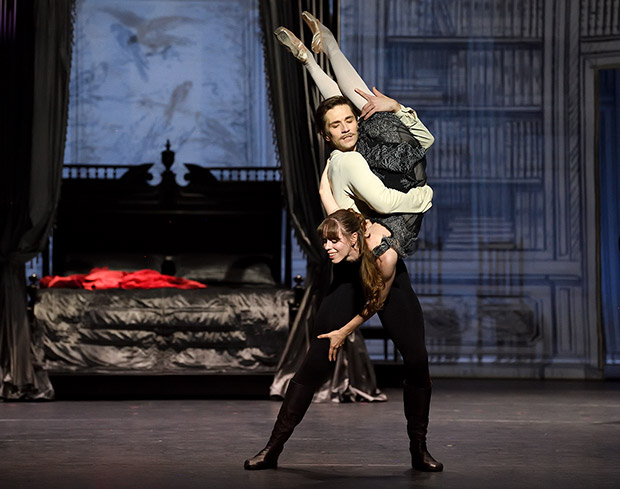
© Stuttgart Ballet. (Click image for larger version)
Stuttgart Ballet
Mayerling
Streamed archive recording of Staatsoper Stuttgart premiere on 18 May 2019
Relay 11-12 April 2020
www.stuttgart-ballet.de
Tamas Detrich, artistic director of Stuttgart Ballet, put online for just 24 hours an archive video of the company’s first performance of Kenneth MacMillan’s Mayerling, 18 May 2019. The recording was made for Stuttgart Ballet’s records, with just one camera situated at the back of the stalls; so not a multi-camera operation to be marketed as a DVD. Although the camerawork was professionally done, with zooms as well as wide shots, by Dora Detrich of the company’s video department, a few key moments were missed. The sound and video quality of the streaming is also dependent on your broadband speed/link – which can be problematic for some, including me. So I am not reviewing the recording so much as commenting on the differences between Stuttgart Ballet’s 2019 production and the Royal Ballet’s version that dates back to the ballet’s premiere in 1978 (with later revisions).
The main difference is the sets and costumes, created for Stuttgart Ballet by veteran stage designer Jürgen Rose, 82. He was John Cranko’s choice of designer in the 1960s-1970s before making his career internationally. (The Royal Ballet uses his designs for Cranko’s Onegin and MacMillan’s Concerto.) Rose could be seen taking his bows at the end of the Mayerling screening, flanked by two assistants.
Like Nicholas Georgiadis, Mayerling‘s original designer, Rose researched the ballet’s period in the 1880s but set it slightly later: the furniture has Biedermeyer elegance; the women’s dresses are less heavily encumbered with bustles. Helpfully, the females in Crown Prince Rudolf’s life are colour-coded: his mistress at court, Marie Larisch, always has touches of green; Mary Vetsera, his nemesis, wears pink; his mother, Empress Elisabeth, is in crimson or black; Mitzi, the courtesan, wears a scarlet dress; his wife, Princess Stephanie, is in white or grey; her sister, Louise, wears sunny yellow. Otherwise, the costumes are variations of monochrome designs.
The sets consist of scrims and gauzes, sketched in shades of grey to suggest rooms within the Hofburg, the Habsburg dynasty’s palace, the Vetsera family’s salon and finally the hunting lodge at Mayerling. They don’t have the looming sense of claustrophobia of Georgiadis’s designs, with the implication that Rudolf is constantly under surveillance. The brothel scene in Act II provides the only touches of colour in its low-life tavern, with graffiti on the walls and revolutionary flags along the back. The whores wear gaudy pieces of military uniform, providing a brief brightness in Rudolf’s life until he meets Mary Vetsera in her fuschsia pink overcoat.
The sets are lovely, lit to appear solid or transparent, with double gauzes to indicate rooms behind rooms. In the final scene, the exterior of the hunting lodge vanishes, as does its interior setting, until nothing is left except a bare white space and the screen behind which the double suicides take place. Then comes the funeral with which the ballet opens. This time, we know it takes places at Mayerling and that the body in the pink coat is that of Mary Vetsera.
The scene in which Rudolf shoots a member of an Imperial hunting party is set in autumn rather than winter. A stag lies dead in the centre of a black and white clearing. The hunters wear traditional Viennese clothing (trachten), with lederhosen, boiled wool jackets and Tyrolean hats. The women’s outfits are colour-coded, so we can tell who they are, though Rudolf is not readily recognisable. Stephanie is no longer pregnant, so some time has passed. (The only child was a girl, Elisabeth Marie. She was five when Rudolf died.)
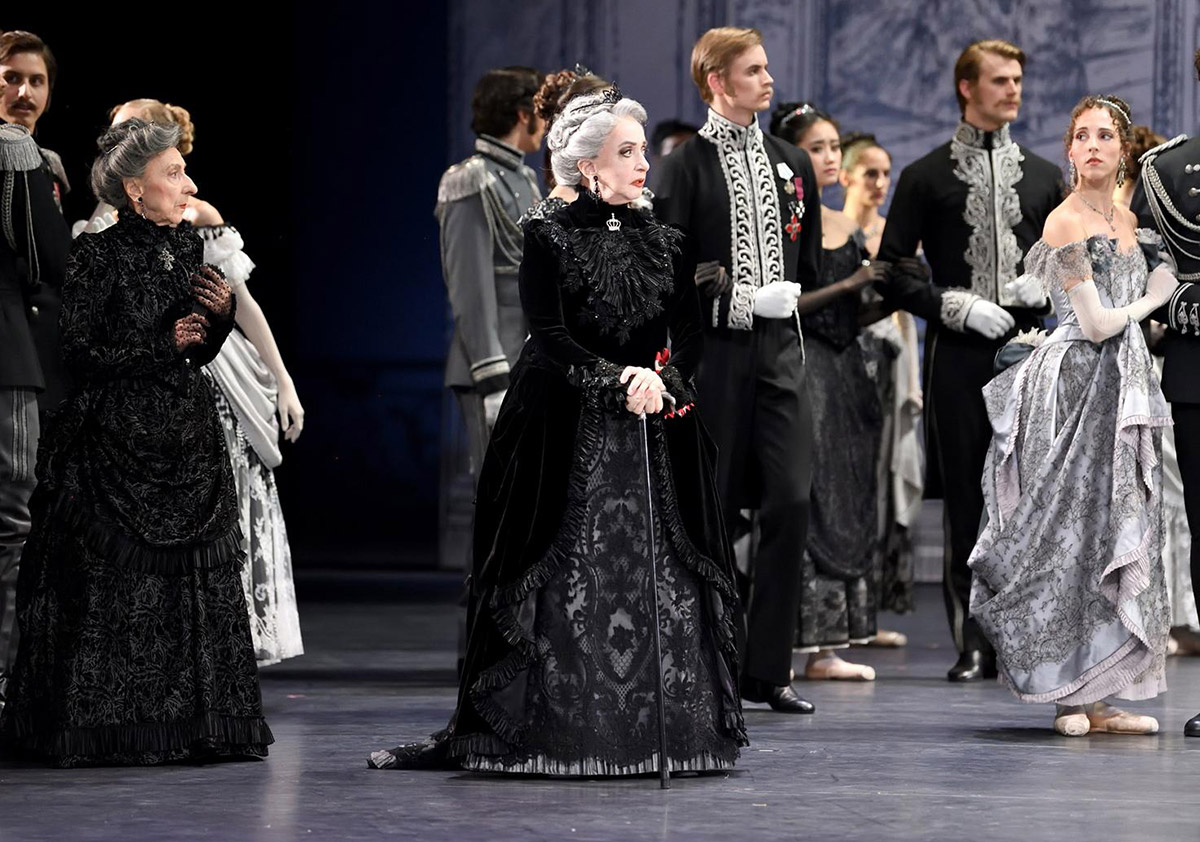
© Stuttgart Ballet. (Click image for larger version)
A further notable departure from the Royal Ballet version is the enhanced role of Archduchess Sophie, Rudolf’s grandmother. (She was actually dead by the time Rudolf was 14, but no matter.) The role was taken in the recording of the premiere by Marcia Haydée, 82, with Georgette Tsinguirides, 92, as her lady-in-waiting. Haydée was Cranko’s principal ballerina, subsequently becoming Stuttgart Ballet’s director from 1976-1995. After directing Santiago Ballet in Chile, she returned as a guest to perform as Juliet’s nurse in Cranko’s Romeo and Juliet and to assume the role of Archduchess Sophie. Tsinguirides became Cranko’s notator in 1966 and has carried on teaching his ballets and others’ ever since.
The aged Archduchess is prominent in first ballroom scene, where she takes the place of honour on the centre stage throne, politely ceded by Stephanie’s parents, the King and Queen of Belgium. Emperor Nicholas I, Egon Madsen, 77, leads his mother into the waltz once Rudolf and Stephanie have opened the dance. She then watches disapprovingly as Rudolf misbehaves with Princess Louise, while the Empress, Miriam Kacerova, pointedly takes no notice. Eventually, Rudolf is taken to task by Sophie, the Emperor and the insulted bride, Diana Ionescu.
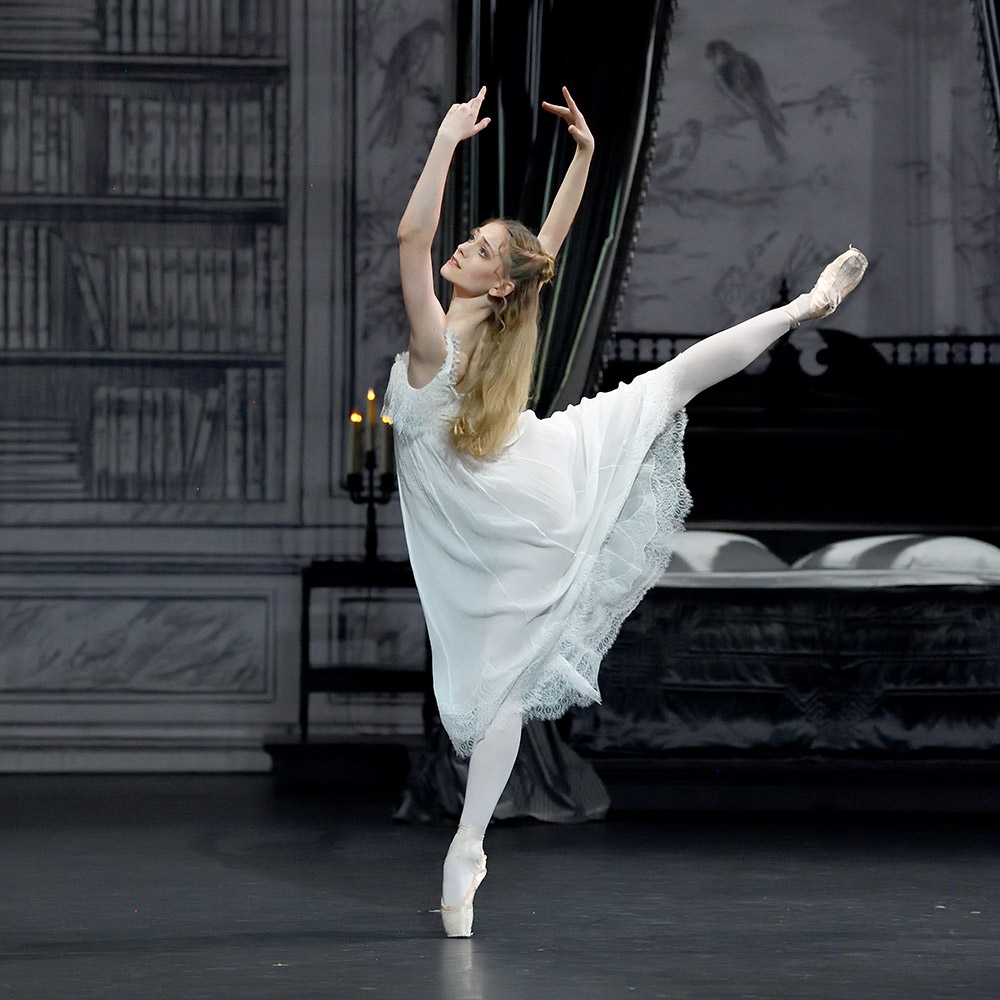
© Stuttgart Ballet. (Click image for larger version)
Stephanie, raped on her wedding night at the end of Act I, is obviously pregnant at the start of Act II, the brothel scene. Royal Ballet Stephanies are not yet with child: the coat she wears is tight-waisted. By the time of the Emperor’s birthday party, attended by his opera singer mistress, Stephanie is heavily pregnant. In Stuttgart’s staging, she is seated next to Archduchess Sophie, whose position is always conspicuous. (Royal Ballet Sophies are less prominent. The first one was Julie Rose; more recently, Ursula Hageli.) Haydée makes it very clear that the Archduchess is appalled by Empress Elisabeth’s condoning of the Emperor’s mistress. She also despairs of Rudolf’s neglect of his pregnant wife, as he stands as far away from her as he can. The camerawork in the screening misses his isolation from the rest of the Imperial household.
So, to judge by Stephanie’s condition, at least four months have passed from Rudolf’s encounter with Mary Vetsera after the end of the brothel scene and Larisch’s delivery of Mary’s letter during the birthday party. Larisch must have been instructing Mary during that time how to please Rudolf. Elisa Badenes as Mary, with her long fringe and toothy smile, resembles Leslie Caron as Gigi – another young girl in training to be a courtesan. Badenes looks very girlish in her pink outfits with a straw boater perched atop her long hair. Once she strips down to her nightdress, however, she is a sexual vampire, feasting on Rudolf’s cravings. (The real Vetsera, at 17, was no innocent.)

© Stuttgart Ballet. (Click image for larger version)
Badenes’s Mary is shocking in her amorality. She’s a practised seductress, unfolding her seemingly bare legs lusciously, holding one suspended over his head like a scorpion’s sting. She is triumphantly pleased with herself at the end of her first pas de deux with him, confident that she has got what we she wants. Her pink coat lies on the bed behind him, all pretence of virginal propriety abandoned.
Friedemann Vogel’s Rudolf starts as a spoilt prince, resenting the claims made on him by his status, his bride, his mistress Larisch and the Hungarian dissidents. In the recording of the premiere performance, Vogel doesn’t fully get into the role until he encounters Mary. MacMillan’s choreography and Liszt’s music reveal what Rudolf must be feeling in Act I but Vogel is intent on accomplishing the succession of pas de deux with different women. The ‘closet scene’ with his mother fails to read effectively because Miriam Kacerova as Empress Elisabeth remains blankly glamorous. Alicia Amatriain’s scheming Larisch has a louche touch of vulgarity, which becomes pronounced in the hunting party scene. She is chilling when reprimanded by Elisabeth before Rudolf’s second pas de deux with Mary; Larisch recognises how far gone he is.

© Stuttgart Ballet. (Click image for larger version)
Vogel now starts to resemble Irek Mukhamedov, dark eyes rolling back in his head. He is an excellent partner of Badenes’s avid Mary, making the tortuous lifts in both the pas de deux with her seem spontaneous. He has lost the earlier caution in his dancing and is immersed in his role. Badenes’s Mary appears to accept the suicide pact because she’s headstrong and a bit clueless. Her pink coat and boater hat emphasise her youth in the final scenes, as if she is still eager to please him.
At the hunting lodge, she and Rudolf are irritated by Bratfisch’s antics, as was I. Adonhay Soares da Silva appears to think the coachman has been hired as the entertainment act at Mayerling. He shows off his virtuoso dancing (though not any hat juggling skill) with a broad grin. He should be desperate to distract Rudolf, rather than simply irked at being ignored.
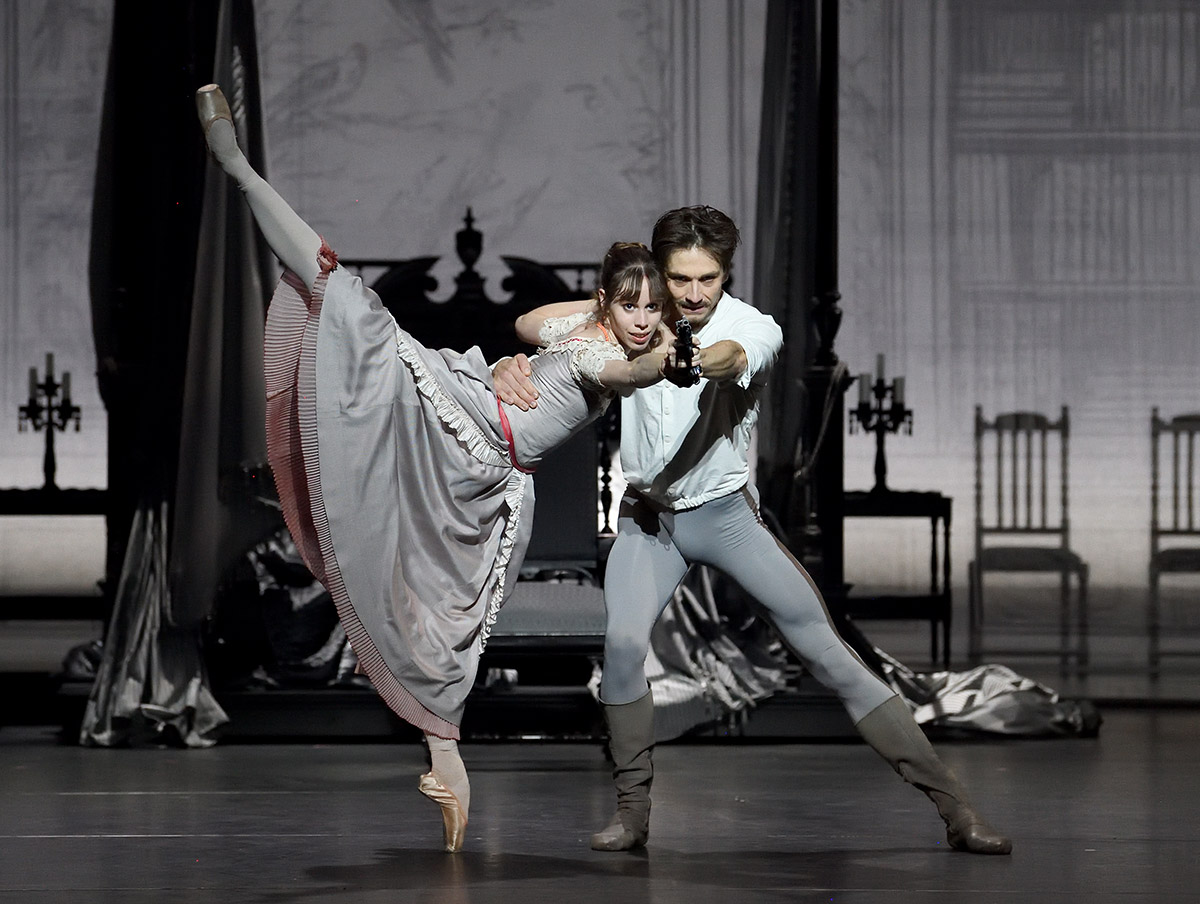
© Stuttgart Ballet. (Click image for larger version)
Mary removes her outer clothing, wearing a white slip with black lace that she must have chosen for the suicide pact. She hurls herself at Rudolf, eager to grab the gun and get high on sex. Once he takes a shot of heroin and no longer knows what he is doing, she holds the gun with him, making sure he goes ahead with the plan. When her corpse is exposed after Rudolf shoots himself, she sprawls on the plinth without being laid out with a flower, as Mary is in the Royal Ballet version. Vogel’s Rudolf is incapable of such a gesture.
Taking his first curtain call, Vogel looked truly drained, almost in tears. After the full cast and principal performers’ bows, the four veterans were honoured: Jürgen Rose, Marcia Haydée, Georgette Tsinguirides and Egon Madsen, their combined ages mounting to 333 years. It is to be hoped that they will still be performing in Stuttgart Ballet’s Mayerling when it returns, eventually, to the Staatsoper stage. It’s a magnificent production.









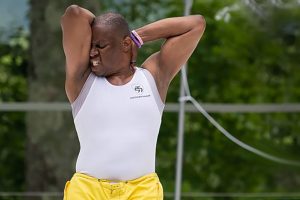
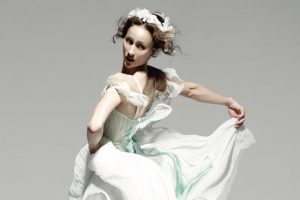

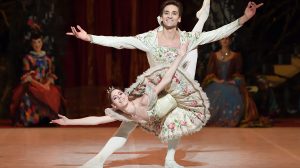

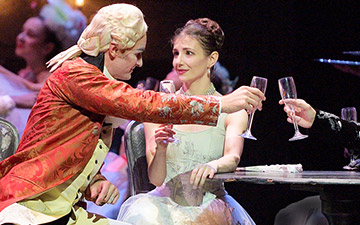
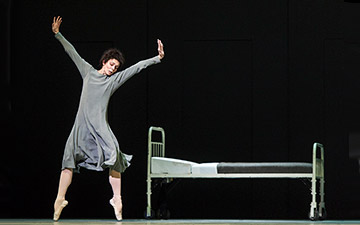

You must be logged in to post a comment.